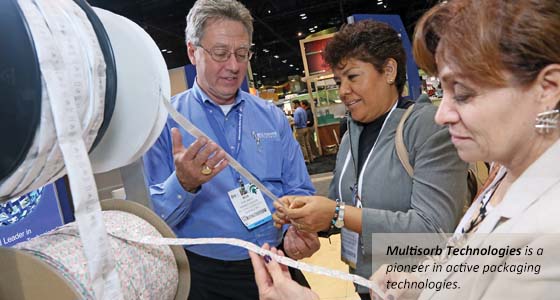Expo Report: What’s Down the Road for Packaging?
PACKAGING

Technologies developed by thousands of trained food packaging professionals are driving a multibillion dollar food packaging industry to feed the 300+ million population in the United States. Food packaging is a virtually invisible discipline that has led and will continue to lead in overcoming hunger and want, and in providing an expanding quality of life. However, the rather obvious paucity of contemporary food packaging information in the 2013 IFT Annual Meeting & Food Expo should be a disappointment and concern to all.
For decades, the IFT Food Packaging Division was the world’s primary early-alert source to communicate innovation: aseptic packaging, modified atmosphere packaging, polyester bottles, microwave packaging, active packaging and much more that drove food science and technology. Of the major technologies selected as the most significant of the Institute of Food Technologists’ first half-century, packaging-based innovations comprised nearly half. During this period, through its industry-funded Riester-Davis award, the IFT Food Packaging Division honored the visionary men and women who pioneered canning, oxygen barrier plastics, case-ready red meat packaging, predictive shelf-life modeling and more. Tee Downes, Mike Gigliotti, Barbara Blakistone, Ray Bourque, Don Riester, and Reese Davis … do you remember them and their contributions?
A rapidly convened brief and too sparsely attended gathering in Chicago to revitalize the IFT Food Packaging Division produced a list of topics that warrant conversion into IFT-sponsored webinars or seminars during the 2014 Annual Meeting: safety of food contact materials, safety of novel food packaging technologies, sustainable package methods, and antimicrobial packaging. IFT members are urged to assert their efforts to bring these to fruition and to renew our Food Packaging Division.
Packaging Innovations at the Expo
And so, what did actually transpire at the 2013 Food Expo that was relevant to food packaging? Flexpacknology’s Tom Dunn (www.flexpacknology.com) plowed through the 2013 venue to unearth innovations and to help me report on the food packaging events. There were eight exhibitors dealing with food packaging on the show floor.
Arena Packaging (www.arenaproducts.com) specializes in intermediate bulk carriers (IBC) in a plastic carrier box including aseptically filled liquids. The company provides management of reusable carrier containers. Arena has received certification to International Food Safety Standard 22000 with 223 “prerequisite programs” for food package material suppliers. Goodpack (www.goodpack.com) is an IBC management organization employing returnable, reusable steel bins around the world.
Bonar (www.bonarplastics.com) is yet another IBC management company, indicating how important this technology is for customers that manufacture and distribute bulk ingredients.
Secondary Packaging
“Microliner” pressure sensitive labels integrate printing and coating on 48 gage polyester film carrier sheets. Labels are aimed at expanded polystyrene foodservice coffee cups, among other target markets (www.outlookgroup.com).
Primary Packaging
Oxygen scavenging active packaging has been pioneered in the United States by Multisorb Technologies (www.multisorb.com). Until last year the company was dominantly in sachets inserted into primary packages. The company’s new oxygen scavenging film structure dubbed Multisorb Fresh Plus™ is to be marketed to converters who will then laminate it to other layers. Since the film color darkens with age and oxygen, Multisorb recommends lamination to opaque flexibles to mask the change.
Contract packager Ameriqual (www.ameriqual.com) has submitted process validation documentation to the U.S. Food and Drug Administration for a no objection letter for microwave assisted thermal sterilization (MATS). The pilot equipment was engineered and built by Food Chain Safety.
Monosol (monosol.com), a subsidiary of Japan’s Kuraray, offers a water-soluble polyvinyl alcohol (PVA) film called Vivos. Applications are for measured dose powders or liquids to be incorporated into mixes. The systems would be considered to be edible delivery for portions of, for example, instant coffee or soup.
A late exhibitor was the Canadian company IPL (www.ipl-plastics.com), injection molder of consumer-size cups, tubs, bowls, and the like. The company introduced oxygen barrier structures that have been tested by university researchers and declared to be excellent oxygen barrier packages as long as the heat seal lidding was hermetic.
--- PAGE BREAK ---
Scientific Program InsightsOur preview column in the May 2013 issue enumerated and summarized all the poster presentations that were classified as related to food packaging. Only a single symposium, “Reduce, Reuse, Recycle: A Sustainable Packaging Approach,” was listed as packaging-focused. It was organized and moderated by Valentina Trinetta of Ecolab and George Sadler of Provelt. The symposium title did not describe the core content, which was active packaging.
Presented by Catherine Cutter of Pennsylvania State University, “Antimicrobial Packaging for Meat and Poultry Products: Sustainability and Regulatory Considerations” offered an overview of both biologically based films and of antimicrobial active packaging.
Bio-based polymers may be extracted from biomass, synthesized from bio-derived monomers, or produced from microorganisms. Polymers extracted from biomass may be broken out as follows.
• Polysaccharides. These include starch that can retard moisture migration, thus lowering water activity and retarding microbiological growth for longer shelf life. Cellulose is resistant to lipids and reduces moisture transfer. Alginates are derived from seaweed and improve moisture retention and reduce shrink and thus extend shelf life. Carrageenan, isolated from seaweed, can incorporate antimicrobials, salt, and antioxidants and thus extend shelf life. Agar has been proposed as a delivery system for antimicrobials. Pectin comes from plants and has been demonstrated to reduce shrinkage and bacterial growth when in film form.
• Proteins. Chitin and chitosan are derived from the exoskeletons of insects and crustaceans and are apparently among the most abundant biopolymers in the world. They have been studied extensively as chelators and antimicrobials. Casein and whey exhibit good mechanical and barrier properties and have been demonstrated to reduce moisture transfer and delay oxidative rancidity. Gelatin displays good gas barrier properties. Collagen, a good moisture barrier, can reduce shrink loss.
• Lipids. Lipid films reduce shrinkage, retard oxidation, and prolong freshness.
Polymers from Bio-Derived Monomers
Commercial polylactate package film is resistant to oils and volatile flavors, heat sealable, and selectively compostable.
Polymers from Microorganisms
Xanthan and pullulan are reported to be heat sealable and to exhibit good oxygen barrier properties.
Bio-based polymers may be applied to animal protein surfaces by foaming, dipping, spraying, casting, brushing, wrapping or rolling.
Antimicrobial Compounds and Structures
Antimicrobial compounds applied to muscle foods through package materials include organic acids, bacteriocins (e.g., nisin, pediocin), grape seed extracts, spice extracts (essential oils), thiosulfinates, enzymes, isothiocyanates, chelators, metals, parabens, esters, and nanoparticles.
Antimicrobials applied to muscle tissue through films appear to be more effective against bacteria than when applied directly.
Antimicrobials may combine with other active packaging technologies to enhance preservation and better retain food quality. Cutter’s presentation suggested that bio-based package materials might be better delivery systems for activity than the current plastic structures.
--- PAGE BREAK ---
Natural Chemistry for Active Packaging
Tom Dunn of Flexpacknology (my co-author for this column) offered patterns to explain why some natural chemical reactions with food systems extending shelf life are commercially adaptable and some not, as well as market trends that affect those patterns. Active packaging extends the time that food is safe and acceptable by cooperation with intrinsic variables. Active packaging improves the condition of packaged food by removing or reversing food deterioration and/or incorporating components that release or absorb substances into/from the food and/or into/from the environment surrounding the food.
Modes of action of active packaging include the following: absorb—absorb flavor/odor and adsorb ethylene; scavenge—oxidize (e.g., metal such as iron, manganese, and cobalt and capture free radicals; control—absorb moisture via clay, polymers, and silica gel and release moisture via saturated aqueous solution; release—antimicrobial (e.g., organic acid, essential oils, and their terpenes and esters, carnasol, rosmarinic acid) and antioxidant (e.g., BHT, TBHQ, tocopherol, ascorbic acid); and emit—carbon dioxide from moisture-activated bicarbonate.
Mixtures of minerals and clays foster removal of endogenous ethylene in fresh produce to below physiologically active levels, thus extending shelf life. Scavengers can remove free radicals. Oxygen is currently removed by reacting with metals such as iron plus an acidifying electrolyte to promote the reaction.
Patterns for active packaging are as follows: leaves the package and becomes part of the product; leaves and returns to the product and package suggesting equilibrium chemistry; or leaves the product and is captured by the package.
These patterns indicate that the relevant variables are descriptive characteristics (reactants exhibit three dimensional mobility; headspace mediates interactions; equilibrium reactions are improbable) and excluded characteristics (reactants with limited surface mobility; vacuum/skin packaging formats; inadequate reactant energy).
The data observed indicate continued acceptance of natural chemicals as active packaging agents with emphasis on organic and inorganic acids. Incorporation into the package structure is more effective than separate sachets. Consumers apparently fear “synthetic chemicals,” leading to a conclusion that so-called natural active substances will be the vehicles in the future. A further conclusion is that hybrid active product/package systems will grow to deliver shelf-life extension.
An Opportunity for IFT
As much as the 500+members of the IFT Food Packaging Division might have hoped otherwise, the 2013 event suffered from a minimum of meaningful deliverances on their favorite topic. Alternative events in the U.S. might be similarly classified. A single interactive source for food packaging technology innovation and development no longer exists. This means that there is a void that IFT membership can fill by identifying the many new technologies that pepper our discipline and communicating information about them to the many who would benefit from this knowledge. Our challenge is to assertively revitalize the Food Packaging Division so that it again becomes the beacon for sparking progress in the field.
 Aaron L. Brody, Ph.D., CFS, Contributing Editor, is President and CEO, Packaging/Brody Inc., Duluth, Ga., and Adjunct Professor, University of Georgia ([email protected]).
Aaron L. Brody, Ph.D., CFS, Contributing Editor, is President and CEO, Packaging/Brody Inc., Duluth, Ga., and Adjunct Professor, University of Georgia ([email protected]).
Tom Dunn, a member of IFT, is Managing Director, Flexpacknology LLC, Atlanta, Ga. ([email protected])
